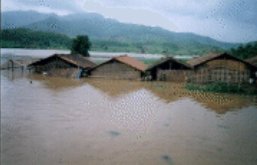On May 14th 2003, the Resettlement and Rehabilitation (R&R) subgroup of the Narmada Control Authority (NCA) gave its conditional recommendation to increase the height of the Sardar Sarovar Dam from its present height of 95m to 100m. This conditional recommendation by the subgroup and the subsequent approval by the full NCA occurred in the face of abundant evidence that the most basic requirements of fair and just resettlement and rehabilitation of affected populations have not been met even at the current dam height of 95 meters.
This is borne out by both state sponsored studies such as the Justice Daud Committee report on condition of oustees in the state of Maharashtra and the subsequent Joint-Task Force commissioned by Maharashtra; and those by independent and respected international groups such as the Housing and Land Rights Network of Habitat International Coalition. For example, studies by the joint task force in October 2002 at the current height of the dam (95m) found that more than 3600 families remained to be rehabilitated (about 3100 families remained near the river and 500 families had shifted to resettlement sites but had not been granted land). This figure for Maharashtra alone implies tens of thousands of people are yet to be resettled and the dam even at its current height is in violation of the law. The condition of the affected people in Madhya Pradesh is worse - a large majority of the 35,000 oustee families are yet to receive rehabilitation. The MP government has openly declared that there is no land available for the oustees and is giving cash compensation, in violation of the NWDT guidelines, which the Supreme Court upheld in 2000.
The state administrations are in continued breach of faith of their citizens. On April 24th 2003, the Chief Minister of Maharashtra, Sushilkumar Shinde in a meeting with affected persons recognized that several of them had not been resettled and assured them that the state would not permit an increase in the height of the Sardar Sarovar Dam until full resettlement and rehabilitation has occurred in the state. Shinde's promise has turned out to be worthless. The move by the Narmada Control Authority was timed precisely to subvert the authority of the Supreme Court The NCA meetings began soon after the Supreme Court went into an extended summer recess from May 12 until July, thereby making it difficult for the aggrieved people to approach the Court for justice.
It happened in May 2002 too!!

![]() Exactly one year ago in May 2002, the NCA had ordered an
increase of the dam height from 90 m to 95 m. The displaced people of the
Narmada Bachao Andolan went to the Supreme Courts
two-judge
vacation bench. The two judges could not come to a consensus on staying the dam construction and at the end of May referred it to a new vacation bench that would sit in the month of June! Meanwhile the dam was raised to 95 metres. The submergence that ensued in the monsoon months of July, August and September swept away several houses, flooded many fields and put thousands of families in danger in the remote hills of the Narmada valley. The Maharshtra state government admitted to submergence without rehabilitation and agreed for a Rs 35 lakh compensation for the immediate short-term crop loss and damage. The families in the valley are still awaiting their rightful land-for land rehabilitation.
Exactly one year ago in May 2002, the NCA had ordered an
increase of the dam height from 90 m to 95 m. The displaced people of the
Narmada Bachao Andolan went to the Supreme Courts
two-judge
vacation bench. The two judges could not come to a consensus on staying the dam construction and at the end of May referred it to a new vacation bench that would sit in the month of June! Meanwhile the dam was raised to 95 metres. The submergence that ensued in the monsoon months of July, August and September swept away several houses, flooded many fields and put thousands of families in danger in the remote hills of the Narmada valley. The Maharshtra state government admitted to submergence without rehabilitation and agreed for a Rs 35 lakh compensation for the immediate short-term crop loss and damage. The families in the valley are still awaiting their rightful land-for land rehabilitation.
Narmada water in Kutch
The arrival of Narmada water in Kutch has been announced recently in the media with fanfare by the Gujarat Government (The Hindu, May 18, 2003). However, as in Rajkot and Ahmedabad, where Narmada water was brought in just before the elections, this will do little to alleviate the chronic water problem there. Furthermore, this is just the drinking water component of the promised Narmada waters. The irrigation water for 37,000 hectares of cultivable land in Kutch is still remains a mirage. Of the proposed irrigation of 18 lakh hectares from the project, only 1.6% of the total cultivable land in Kutch (37,000 ha.) and 9.2% land of Saurashtra would get water from the Sardar Sarovar Project.























